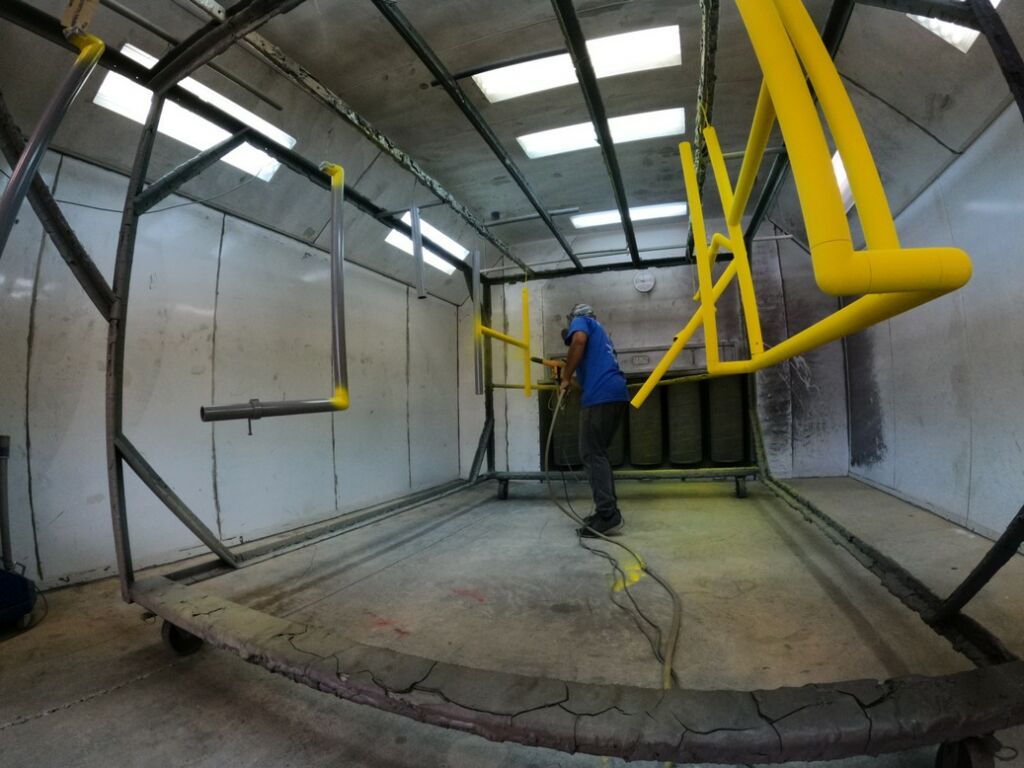Sand Blasting Before we can powder coat, the surface needs to be cleaned. Sand blasting is used to clean surfaces and prepare them for a new finish. It is also an effective method for removing rust, oxidation and old paint. Old gates, railings, metal parts or any other metal piece can be stripped clean using this method.
Sand blasting is carried out in a special booth and the worker is required to wear safety gear. An abrasive mineral (garnet) is forced through the nozzle of a specialized blasting machine at high pressure to blast away paint and rust. The abrasive material is propelled by compressed air.

Powder coating is an advanced method of applying a decorative, protective finish to a wide range of materials and products. The powder used for the process is a mixture of finely ground particles of pigment and resin, which is sprayed onto a surface to be coated.
The dry pigmented powder, if held in your hand, looks and feels like colored BABY POWDER. It is also just as safe. Basically because it is free of the hazardous volatile organic compounds (VOC) contained in liquid paints. The powder is applied electrostatically. “Charging” the powder with voltage and spraying the item, which is hung with metal hooks.
Today, powder coatings are available that result in a highly durable finish in a variety of colors, glosses and textures. New formulations in powders have made it possible to achieve innovative finishes that are above and beyond liquid paints.
Next, the item enters an oven and is cured at approximate temperatures from 300° to 400°F. Any materials that cannot withstand this time and temperature exposure must be removed before coating. This would include foam insulation, rubber, plastic, bushings, paper or gaskets.
Powder coatings have become the coating technology of choice for consumable goods from toolboxes, bicycles, office furniture, and lawn furniture to widespread markets such as appliance and automotive for the reasons listed below.
- QUALITY: The unique application characteristics of powder coatings provide superior consistency and uniformity of finish without sags, drips, or runs. They provide extremely tough, durable films, enhancing the high quality, value-added image of consumer products. In general, the performance properties, such as impact resistance, flexibility. and corrosion resistance, of powder coatings are better than liquid paints. Powder coated parts resist cracking, peeling, and marring during handling and normal service use. In many cases, merchandise is specifically being advertised as "POWDER COATED" because of the quality image it projects.
- ECONOMICS: Powder coatings are frequently a cost saving alternative to liquid paints with respect to energy savings, labor costs, rework costs, material usage, waste disposal, and overall line efficiency. The advantage to manufacturers and the consumers is a coated part with a superior quality finish at a reasonable cost.
- ENVIRONMENTAL: Environmental issues are of significant interest and importance to the government and general public today. Unlike many liquid paints, powder coatings are compliant with environmental regulations. Liquid paints often contain solvents, which can contribute to air pollution and, in some cases, ozone depletion. Powder coatings are free of such pollutants. Wet painting processes can generate sludge, which must be disposed of into hazardous waste landfills. Properly formulated powder coatings generate no such hazardous waste. The consumer can feel good about buying a powder-coated product, which is ENVIRONMENTALLY RESPONSIBLE.

